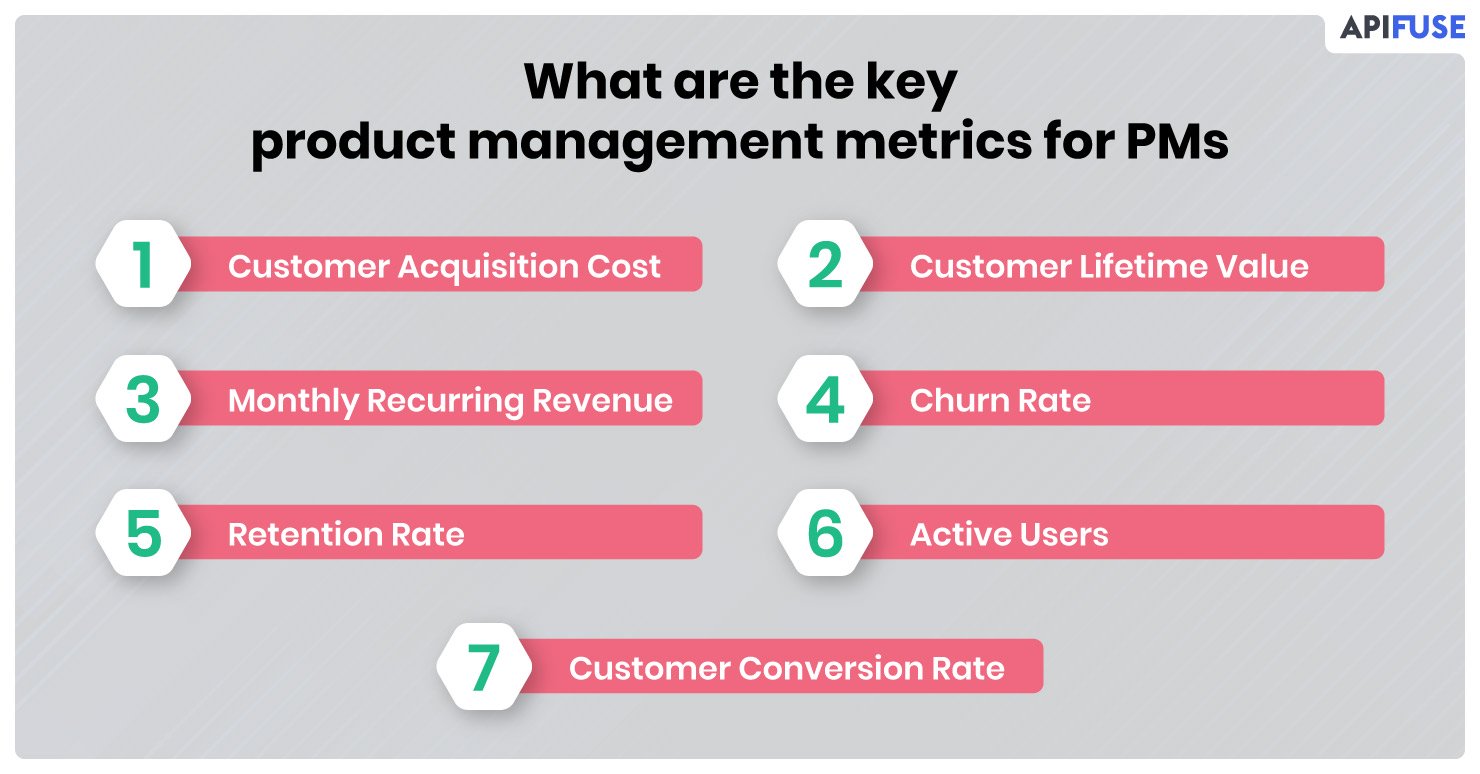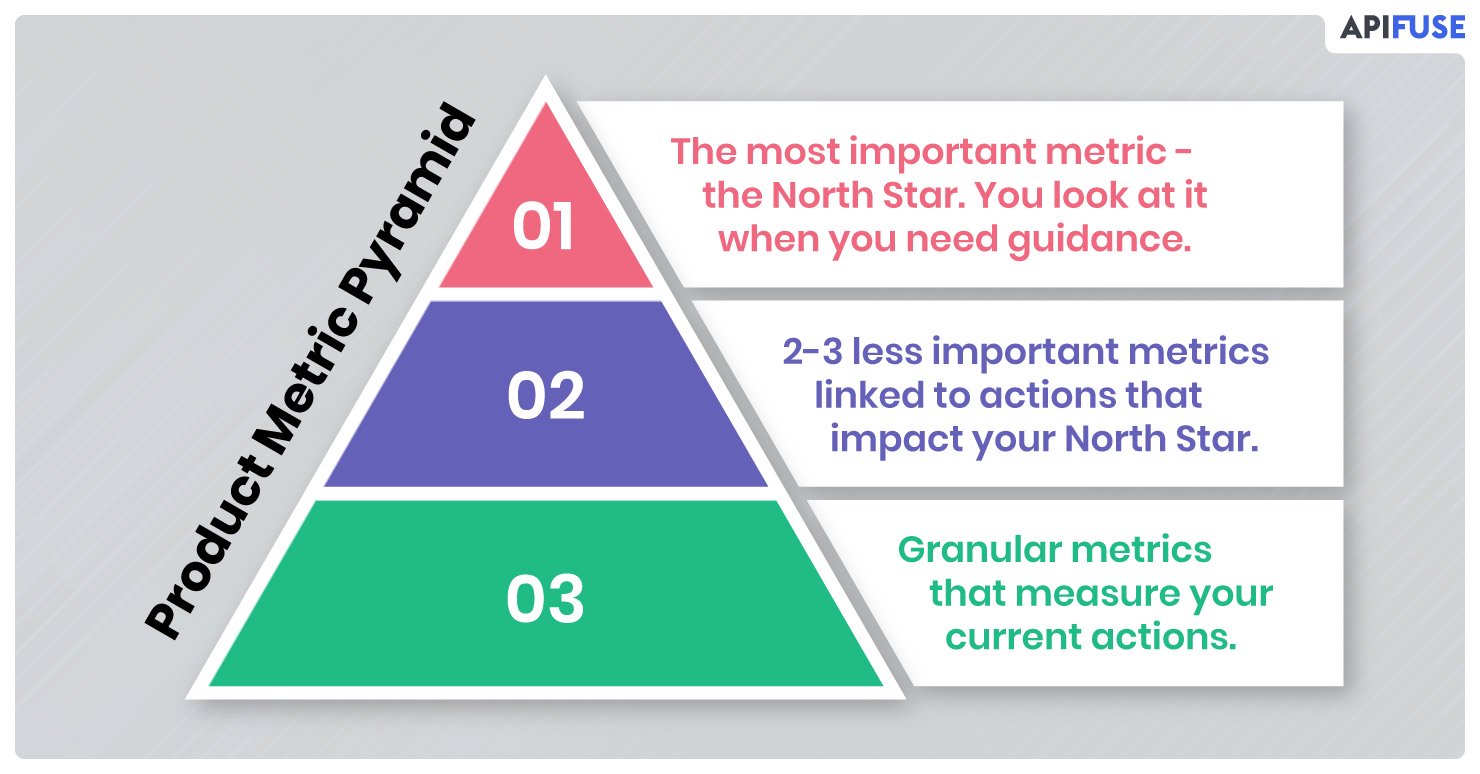Gut instinct has its place, but a product manager cannot depend on intuition alone for a product health check. They need hard data.
What kind of data?
Product management metrics like churn rate and MRR. These metrics are data points that a SaaS business can track and analyze to evaluate how well its application is doing.
Because these metrics link back to the product strategy, they offer PMs quantifiable, objective support needed when creating a product roadmap.
What happens when you don’t have product management metrics?
Without key metrics, PMs are left with guesses and speculation when prioritizing integrations vs. core features. They are also forced to guesstimate the return on investment on a proposed feature, making it tougher to get a green-light from executives.
Why are product management metrics important?
Metrics matter because they help PMs make better product decisions.
Often referred to as KPIs (key performance indicators), they are solid proof of which parts of your product work, which don’t, and what users may want in the future.
The sales, marketing, or product team can also leverage these metrics. Using the data, they can assess the motivation behind user personas and improve their processes as well as products.
They are harbingers of failure
Besides helping you make your product better, product metrics are early alarm bells. They tell you what aspects of the application or UX is not working. This is crucial. Why? Because users often never complain.
They do not chat with your support team for help when stuck. They don’t usually email you feedback about glitches in your product. They either stop using that feature or drop your product altogether.
So, how do you stop churn when you don’t even know there is a problem with your SaaS product? You take a look at key metrics that warn you way ahead of time, such as:
- Average product interaction time decreasing
- Usage of particular feature dropping off
When you focus on the right metrics, you can locate the problems and trends early and then get to solving them!
What are the key product management metrics for PMs?

You know a product roadmap is essential. You know, to achieve the goals set in the roadmap, you need to measure product metrics. But there are dozens upon dozens of them.
Which ones should you track?
That depends upon the nature of your SaaS business and its goals. Do you want more leads? Do you want more API calls? Or do you want input on a brand-new feature?
Even with these filters, product management metrics remain unmanageable. That’s why successful product managers pursue only a core set of KPIs instead of measuring everything.
By focusing on a few but essential metrics, they achieve business goals with ease and swiftness. With that in mind, here are some product management metrics every PM should measure.
1. Customer Acquisition Cost
CAC is the estimated cost of acquiring a customer. This cost is all-inclusive and considers every penny you spend, whether on sales, advertising, marketing, or product.
Why is it important?
The most significant cost for SaaS companies is acquiring new customers. You cannot spend 5 dollars to get one new user when your product’s price tag is just one dollar. That’s just bleeding money.
Accurate CAC tells you that you’re not committing economic suicide and that the business can scale.
How to calculate it?
Customer acquisition cost is the aggregate of all expenses to acquire new users divided by the number of unique users in a given time.
When to use it?
CAC is a vital metric for every product manager, irrespective of the nature of your SaaS business or growth stage. It’s useful for allocating resources and budget planning. It becomes even more helpful when tracked with customer lifetime value.
2. Customer Lifetime Value
CLTV, LTV, or CLV is the estimated total revenue a customer brings to your business in their entire lifetime.
Why is it important?
LTV is a useful metric because it tells you the worth of customers and how much you can feasibly spend on new prospects and existing users.
When evaluated along with CAC, it shows your real ROI. LTV needs to be at least 3X your CAC.
How to calculate it?
A simple way to calculate LTV is by multiplying the average revenue generated from a user in a specific period with their average lifetime.
A better way is the average dollar amount of a purchase multiplied by the number of purchases made multiplied by the average customer lifetime. Do note that the time period remains the same for the first two factors.
When to use it?
PMs of products that have been on the market for sufficient time should leverage LTV. If your product is still new and you are looking for early tech users, then LTV is not a great metric to track because you can’t accurately determine the average lifetime of a user.
3. Monthly Recurring Revenue

MRR is the total revenue your application generates in a month. This metric is viable for SaaS business because revenue generation is not a one-off. It recurs either monthly or annually, in which case the correct metric to shadow is annual recurring revenue (ARR).
Why is it important?
The need for this metric is self-explanatory. It tells you if you’re earning from users and how much. It takes into account revenue from new customers and any revenue generated by selling expansions or upgrades to current customers.
How to calculate it?
The simplest way to calculate MRR is the sum of revenue generated from all users in a month.
A more precise method factors in all your recurring revenues. The formula is – MRR at the start of the month plus MRR from new users plus MRR from add-ons to existing users minus MRR of churned users.
When to use it?
Every PM should measure MRR at all times, particularly when your product has just entered the market. Monitoring it tells you how well your product is doing.
4. Churn Rate
Churn tells you how many users stopped using or paying for your product. There are two types – customer churn and revenue churn. The first shows you the number of users dropped and the other revenue loss due to customer churn.
Why is it important?
Churn rate is a telling sign of how good your application is. When it is high, it shows that users are dissatisfied with the product. Besides, a high churn directly and adversely impacts recurring revenue.
That said, even the best of products see some churn. It is natural for a small percentage of customers to not renew a subscription or cancel it. As long as the number is at a healthy low, it is not of import.
How to calculate it?
Churn rate is the total number of lost customers in a period divided by the total number of customers during that period. Say you have 10,000 users at the start of January. By the end, 1000 have left. Your churn rate is 10%.
When to use it?
Customer and revenue churn is another metric that all PMs should monitor at all times, irrespective of the growth stage. You need to know how many users are dropping off and at what point. It becomes even more imperative if you are trying to capture the majority audience.
5. Retention Rate
This product management metric gives you an estimate of loyal customers. It is the total number of current customers who continue to use your product.
Why is it important?
Retention rate is crucial when you compare it with your churn rate. It gives you a visual of how many users are sticking around as opposed to those leaving.
How to calculate it?
The number of users at the end of a period subtracted by new users gained in the same period divided by users at the start of the period gives you the retention rate.
When to use it?
The metric gains importance when you’re thinking of capturing the majority audience. If your retention rate is high at this junction, it means users are sticking with your product, proving what you have built works.
6. Active users
Active users can be monthly (MAU), daily (DAU), or weekly (WAU). It is the number of people using your application in a given time. It doesn’t encompass users who did not renew or canceled in the past.
Why is it important?
When you need a metric to give you a fair idea of the size of your user base, then active users are the best benchmark. It is also necessary because it attests to the customer base’s growth and your expansion in the market.
How to calculate it?
Define the criteria for active and then track the total number of users interacting with your product while fulfilling those criteria in 24 hours. It gives you DAU. The same number in a week is WAU, and for MAU, you sum the total number of users in 30 days.
When to use it?
Active users give you a glimpse into the adoption and usage of the entire product or even a particular feature. By monitoring it, you gain insight into when and why a user stopped being active. This allows you to take intervening steps.
7. Customer Conversion Rate
Customer conversion rate is a measure of the number of users doing what you want. It could be switching from a freemium to a premium plan. It could be integrating your product with other apps.
Why is it important?
When you have a low conversion rate, it is proof positive that users are not finding what they wanted or expected. In short, they are disappointed.
On the other hand, if the conversion rate is high for a particular feature, but the number of active users is low, it makes you aware that discoverability is an issue. You can then work on ensuring more users find that feature.
How to calculate it?
For a consistent time period, divide the number of customers completing a particular action by the number of ‘visitors’ to that action to get the customer conversion rate.
When to use it?
If you’re a product manager of a new product, use conversion rates. It helps you spot features that are not working well. It can also help you detect drop-off points.
Rely on a Product Metric Pyramid
A SaaS business can capture thousands of data points. But studying them all is just not practically possible.
Therefore, you have to measure only those product metrics which bring you the most insights to take actions that grow your business. Otherwise, you’ll be drowning in a sea of data.
How do PMs avoid such a scenario? By relying on a product management metric pyramid.
The pyramid breaks down your most important KPIs. The tip is the North Star, the guiding metric. Underneath are the key metrics that influence the North Star. Right at the base are levers – metrics that matter to initiatives you are currently taking.

You can’t manage what you can’t measure.
This axiom is increasingly used in many industries to cut down loss and waste. But it applies surprisingly well to SaaS businesses too.
Product management is increasingly becoming data-driven. To build great products, PMs need data-based goals. For that, they need to track metrics.
If you don’t measure metrics, you are in the dark about what aspects of the product need improvement or how. Product management metrics tell you exactly where you are going and how far (or close) you are to your business goals.
API Fuse enables you to offer on-demand integrations and to respond to end-users integration requests rapidly. With our solution and range of plans, you can offer your customers native or custom integrations embedded directly into your SaaS app in minutes to accelerate your product roadmap and reduce technical debt. Request a demo today for more information!
